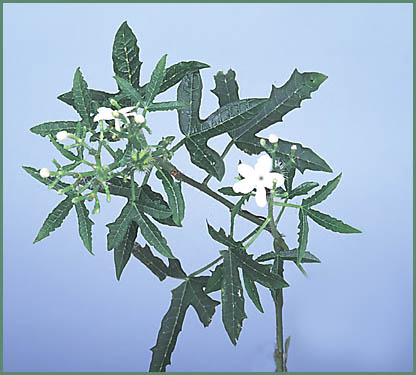Tread Softly
Cnidoscolus stimulosus
Family: Euphorbiaceae
Natural History

White flowers and deeply-lobed leaves of tread softly
Photo credit: SFRC, University of Florida
Tread softly, also called bullnettle, spurge nettle, or finger-rot, is one southeastern native to beware of. The tiny stinging hairs that cover the plant can cause a reddish rash and painful, stinging sensation if they are touched. While the effects are not serious, the pain may persist for up to an hour. This is a member of the family Euphorbiaceae, or spurge, which is known for its toxic substances. Some Euphorbes have toxic sap, latex, or seed oils, while others, like this one, have venomous hairs. The tubers of the plant are edible but the upper portions should be avoided.
Bob-white quail and several species of songbirds consume the seeds of tread softly. Wildlife are the primary dispersers of the seeds, however, the plants re-grow prolifically from the fleshy, persistent tap root.
Tread softly is found in coastal plains from Virginia to southern Florida and west into Oklahoma, Texas, and Louisiana.
This plant is occasionally called "stinging nettle," but that common name is usually reserved for Urtica dioica and other plants of the genus Urtica in the family Urticaceae.
